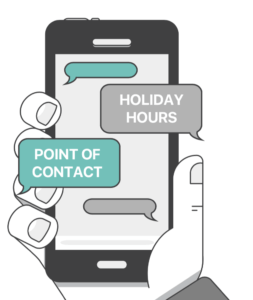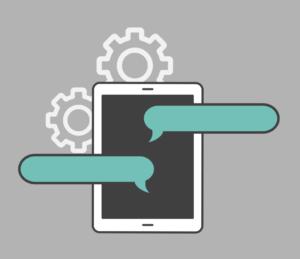
Text messages are considered more personal and immediate than most other modes of communication. However, without the help of organizational software, it is difficult and time-consuming to manage and track business text messages sent from individual phones by your employees and customers.
Heymarket is an enterprise-class solution that delivers a professional text messaging service enabling businesses to add text-messaging capabilities to more common voice and email communication streams.
It brings the same level of utility and organization to text messaging that already exists for email and voice channels, empowering organizations to substantially improve marketing, sales, and customer service processes—while boosting profits.
The Best Practices Guide
With a solution as capable and broadly applicable as Heymarket, there are so many potential use cases that it can be hard to pick the best options.
This guide, divided into customer service/support and marketing sections, will identify a number of proven, real-world examples that will help you generate ideas for specific implementations in your organization.
Customer Support/Service Best Practices from Heymarket
Best Practice #1: Provide a Single Phone Number for Text-Based Support
Text messaging is becoming an important method of customer service and support. However, many businesses have no central or consistent phone number for this service. When an employee leaves or changes position, those support texts may be lost or misdirected, negatively impacting the customer experience.
Using Heymarket, it is now possible to have a single, dedicated text message number for customers to contact. Messages sent to the central number are distributed to the correct teams, and multiple employees can view all messages in a single inbox. Anyone in the team can assign the message to themselves and reply.
This process also ensures better customer support, as it is now easier to expand “off hours” coverage of the customer support function and ensure staff coverage of the support center regardless of paid time off or employee vacations. Businesses can also benefit by creating different numbers for different segments of customers by region, by team, or product/service.
Best Practice #2: Introduce Support or Customer Service Staff Quickly
Many businesses find it’s critical to introduce their support or customer service staff to customers as soon as the relationship begins. In some scenarios, it is essential that the personal contact information for the support person or staff is delivered or the support process is communicated effectively.
Unfortunately, older approaches often do not lead to successful introductions. Customers receive a lot of email every day and may screen calls, which lessens the effectiveness of email and voice outreach. This is where Heymarket text messaging truly shines.
With much higher “open” or successful contact rates, your business will be able to ensure that new customers are immediately engaged with their support or service time. For some businesses, the ability to transition from selling to an active customer relationship will determine the eventual success or failure of that relationship.
Using Heymarket is a new tactic and its novelty, plus customers’ familiarity with texting, makes it even more effective.
Best Practice #3: Improve the Speed of Customer Response
 Text messaging is a medium of quick responses. Using the Heymarket solution improves response speed for both customers and your own organization.
Text messaging is a medium of quick responses. Using the Heymarket solution improves response speed for both customers and your own organization.
From the customer’s perspective, having the Heymarket text messaging system ensures that their text will be routed to a support or service team member who will respond quickly and accurately based on their access to consistent content designed for the text messaging service.
From the employee’s perspective, customers are more responsive with text messages than other mediums. This means that support reps will quickly discover whether a proposed solution was acceptable and if there are any other actions that are required before that particular support ticket can be closed.
Best Practice # 4: Enhance Support with Pictures
Many customer service and support organizations are finding that the use of photos and videos improves the likelihood of a positive outcome.
Currently, phone-based support is followed up with an email that includes a file attachment. This process has limitations:
- The process is time consuming.
- Customers experience a substantial time lag as they wait a few minutes to an hour for the email.
- Personal computer firewalls often block attachments.
- Customers are unlikely to reply whether the image provided a solution.
The Heymarket solution combines the immediacy of text messaging with native support for images. Further, the customer can usually determine in real time if that image (or a link to a video) will solve the problem or if there is a need for more image-based explanation.
Upgrading your support or service experience with Heymarket is a competitive differentiator in many vertical markets where the pre-sales support process has not changed in decades.
Marketing Best Practices for Heymarket
Best Practice #1: Make More Personal Introductions
When businesses reach out with marketing programs, it is difficult to engage with a new prospect in a personal manner. Text messaging from employees with whom the customer has a relationship solves this problem.
 Text messages are perceived as personal and more focused than other formats (blast emails, for example). Since the messages are coming from someone they know and not a machine, customers open these messages at a much higher rate than blast emails.
Text messages are perceived as personal and more focused than other formats (blast emails, for example). Since the messages are coming from someone they know and not a machine, customers open these messages at a much higher rate than blast emails.
Heymarket is focused on having humans generate each message—not bots, rules, or other software. Human-created messages are more personalized, and achieve much higher response rates. This approach has the benefit of starting a relationship between an employee and the customer or prospect.
In fact, Heymarket reports that the open rate for text messages is 98% and the response rate is an astonishing 80%. For those with experience tracking the open and reply rates common in email marketing, these numbers are truly astounding.
Best Practice #2: Leverage Your Existing CRM Data and Contacts
Many businesses have a tremendous amount of valuable data stored in their existing CRM systems. Using Heymarket, it’s possible to leverage this information using an entirely new communication medium.
Custom fields and content that are contained in the CRM system can be integrated into Heymarket so that the text messaging outreach can be highly customized and this activity can be included within a larger CRM “activity” context.
Using the CRM system with Heymarket allows you to narrowly focus text messages to specific recipients and even add a much higher degree of personalization that will make the message even more attractive. In cases where customers or prospects are not responding to email or voice outreach from the CRM system, text messaging can be incorporated to improve response rates.
It can also work both ways: the content of the messages themselves can provide valuable insights that can be leveraged by CRM systems.
Best Practice #3: Standardize and Increase Effectiveness of Content and Formats
Many businesses want to use a consistent format for their messaging with content that has been approved by management and is proven to have the best results. Instilling this discipline is simple for email and voice communications, but has been difficult to extend to text messaging.
With Heymarket it is now possible to standardize the format and content of text messages. This consistency ensures that commitments to customers, discussion of product or service features, and pricing or terms are not altered by individual employees.
This also increases the efficiency of text messaging activity, as the employees can use “pre-built” messages or message streams that have been approved by the management team.
Best Practice #4: Implement Structured and Sequenced Messaging
While most view text messaging as a “back and forth” medium, the reality is that the ability to send a planned and structured series of messages in a sequence that engages the prospect is a powerful tool.
 It is now possible to create a campaign that will regularly contact a customer with resonant content. With sequenced text messaging, you can also leverage existing email nurture streams that have been designed by the marketing team. Sequences of messages can be driven by a calendar or other triggers that make the most sense for the business and prospects.
It is now possible to create a campaign that will regularly contact a customer with resonant content. With sequenced text messaging, you can also leverage existing email nurture streams that have been designed by the marketing team. Sequences of messages can be driven by a calendar or other triggers that make the most sense for the business and prospects.
Text messaging is an entirely different medium from email, allowing organizations to develop creative new campaigns that are enabled by the new technology found in Heymarket.
Best Practice #5: Streamline Lead Generation
Many prospects want to use messaging, rather than phone calls, to get more information about services or products.
Using Heymarket, it is possible to publicize a single incoming text messaging phone number in all marketing material. As a best practice, you can use a different phone number for each campaign. It’s a great way to segment prospects and assign them accordingly.
The messages that come into the Heymarket system through this central number can be assigned to individual employees for personalized follow-up.

Summary
Using text messaging to empower businesses and enhance communications with customers and prospects is a relatively new process—but one that holds the promise of numerous benefits.
Forward-thinking businesses can take this opportunity to communicate with their customers in a way that is natural—and productive—for both parties. Customer and prospect adoption is rapid as they are very comfortable in using this medium; in fact, it’s already a part of their daily digital life.
If you’d like to see more examples of how to effectively use Heymarket, or get more information about the solution, we’re here to help.





